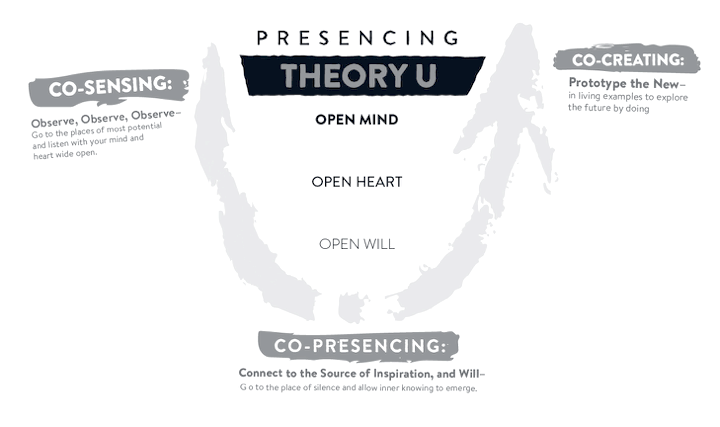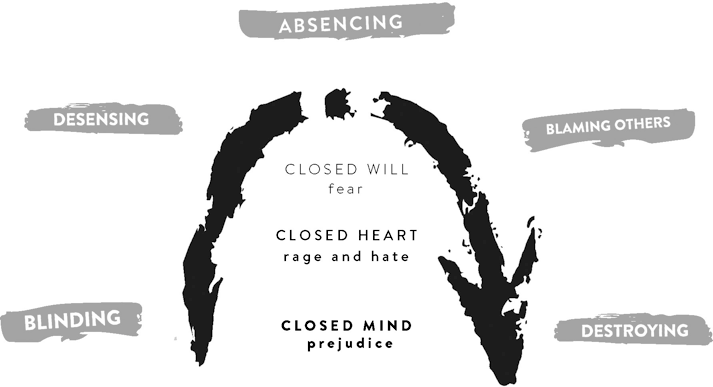Theory U
Episode #5 of the course 10 tools for change by Kate Sutherland
Congratulations! In a few minutes, you will be halfway through the course!
I hope you see how each tool is unique, and just what is needed for a specific purpose. And how together they are profoundly powerful!
I’m excited to share today’s tool, Theory U: a framework for catalyzing innovation and breakthrough in complex situations (and any time the way forward is not clear!).
Origins
Theory U distills findings of research at MIT by Otto Scharmer, with Joseph Jaworski. In the 1990s, the pair conducted 150 interviews with scientists, and with business and social entrepreneurs, at the frontiers of innovation and leadership.
Those conversations revealed an important similarity: breakthroughs in the interviewees’ work came from learning to “presence” an emerging whole.
What does Scharmer mean by “presence”?
The specifics of how interviewees “presenced” differed greatly from person to person, but the overall pattern was clear. After immersing themselves in the system they cared about, something palpably different would emerge “out of nowhere” or in a moment of “grace” (though not always). Entrepreneurs had clear intuitions about great ways forward, and scientists spoke about different, more intuitive ways of knowing that gave them breakthrough insight into their work.
Like Archimedes soaking in his bath, they had “eureka” moments!
There are now tens of thousands of initiatives and projects led by social entrepreneurs, business people, and governments using Theory U to replicate the process revealed in the interviews.
You Can Do It Too!
To support breakthrough change in your context, Scharmer recommends going on a three-phase journey, one that traces the shape of a “U.”

1. Sensing (begin at the top of the left-hand side and move down the “U”): Immerse yourself in the current reality of your situation. Go beyond first impressions to see deeper layers of what is. Ask probing questions of a cross-section of everyone in the system. Research or visit great things happening elsewhere. Slow down to see things differently, and open your mind and heart. Notice patterns.
2. Presencing (at the bottom of the “U”): Retreat and reflect. Be present—full with a heightened awareness of what is and empty with a spacious openness for what is emerging. Be open to seeing and sensing from your deepest source, the way that an artist waits on the creative impulse. Quiet your mind, and listen for the future that wants to emerge. It cannot be forced. With grace, the energy shifts. Often, this comes not as an idea, but as a feeling, a felt-sense, or a direct embodiment of something new that comes “from a different place.” You (and others, if you are in a group) will sense that a threshold has been crossed.
3. Creating (moving up the right-hand side of the “U”): Once there is a glimmer of clarity about the desirable future, the next step is to unfold more of it. Create a “good enough” prototype, quickly, and get it out into the world. Do not hold things back, trying to make them perfect. Keep things moving. Keep learning. Keep adjusting.
Absencing vs. Presencing
What do most of us do instead? Scharmer argues that we tend to do some variation on the diagram below! Instead of being present to what is, we turn away and distract ourselves. Instead of opening our mind, heart, and will, we close down. This is understandable in the face of overwhelm. The challenge: Things usually get worse.

Finding Our Way
In every human system, we need breakthroughs. Theory U is an excellent guide. It does not tell us where we will end up, but it offers a clearly defined process to follow—one that gives us solid footing in challenging situations and that has helped many before us to do excellent work. You can trust Theory U the way that you can trust a compass. Let it guide your journeys, and you will be able to take leaps of faith.
I particularly hope that you resonate with Theory U’s sense that the future is seeking to emerge—that life is emergent, unfolding in wondrous and non-linear ways. It expresses a basic optimism. Yes, the challenges we face are complex and unprecedented, but if we have the courage to go into the unknown, the patience to listen deeply to life, and the willingness to experiment, we can unfold futures better than we could have imagined.
Tomorrow’s tool is Enterprise Facilitation. It increases the likelihood that prototypes, projects, or community initiatives will thrive. As with all the tools, the ideas are relevant in your personal life!
Till soon!
Kate
Recommended book
The Essentials of Theory U: Core Principles and Applications by Otto Scharmer
Share with friends

